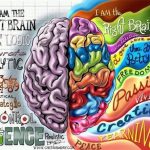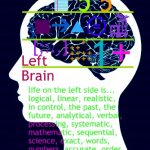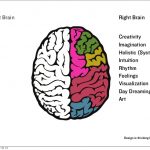Bridging the left and right brain:
-
Helps Us Communicate More Effectively;
-
Reduces Stress And Anxiety;
-
Develops Our Creative Problem Solving Skills; and
-
Allows Us To Live Richer More Meaningful Lives.
 Bridging the left and right brain is valuable, because when we combine both the left and right sides of our brains we develop a new understanding about:
Bridging the left and right brain is valuable, because when we combine both the left and right sides of our brains we develop a new understanding about:
1. The world that we live in;
2. The people that we interact with;
3. The things that happen to us.
It is also very good for helping us to develop Discernment and Embrace the Divine Feminine within, which is a focus for many at this time of global change and awakening.
Most People Favour One Brain Hemisphere For Thinking And Reasoning
While humans are designed to have two functioning hemispheres that work in harmony, filtering, sending and receiving electrical and neuron impulses via the corpus callosum, most people don’t consider bridging the left and right brain and use one side of their brain more than the other to communicate, think and make sense of the world.
Left Brain Thinking
 If you are left brain dominant you spend lots of time thinking, being logical and examining details to make sense of the world. While this is the favoured way of thinking in the western culture as it creates logical, sequential thinking patterns that supports scientific reasoning and intellectual progress, predominantly left brain thinking also cultivates anxiety, depression and high stress levels. The constant need to compare and contrast, and judge whether or not something or someone fits into the pattern, (ie is the same as everything else) affects the way left brain thinkers socialise, because left brain thinkers compare and contrast everything to see if it fits or belongs. This means that anyone or anything that is different may be considered weird, strange and too unfamiliar… (it doesn’t belong to the categorising that the left brain does to make sense of things).
If you are left brain dominant you spend lots of time thinking, being logical and examining details to make sense of the world. While this is the favoured way of thinking in the western culture as it creates logical, sequential thinking patterns that supports scientific reasoning and intellectual progress, predominantly left brain thinking also cultivates anxiety, depression and high stress levels. The constant need to compare and contrast, and judge whether or not something or someone fits into the pattern, (ie is the same as everything else) affects the way left brain thinkers socialise, because left brain thinkers compare and contrast everything to see if it fits or belongs. This means that anyone or anything that is different may be considered weird, strange and too unfamiliar… (it doesn’t belong to the categorising that the left brain does to make sense of things).
The way the left brain works also helps creates stress and anxiety because it makes left brain thinkers want to belong and be the ‘norm’…which means they may not feel they belong if they feel, look, or sound different. An add on effect of this is that left brain thinkers may never feel comfortable in their own body, with their own behaviour and with their own skills.
They want to be themselves, they want to do what they feel compelled to, and they want to like their own body etc, but because it is different to the ‘norm’ it sometimes makes it impossible for them to like or embrace their individuality and uniqueness.
This also creates anxiety and affects left brain thinkers self esteem because this comparing and contrasting develops an unconscious sense of never being good enough – and so they never feel good about what they do and the choices that they make, and they always see someone or something else as better or worse than what they aspire to. This can then create ‘perfectionism’ where no one and nothing – including themselves – meets their standards.
Left Brain thinking and making sense of the world also develops competitiveness; and makes individuals strive for success. This in turn affects behaviour, the ability and need to belong and the capacity to sensate and explore feelings.
Right Brain Thinking
 Right brain thinkers who are not bridging the left and right brain predominantly focus on non-verbal cues, bodies, sensations, feelings, colours, sounds, images, intuition and gut instincts to understand and make sense of the world. They do not focus on what is different and what doesn’t belong, they are instead holistic thinkers and experience everything as unique, but part of a whole, and they can innately celebrate the uniqueness that brings everyone and everything together.
Right brain thinkers who are not bridging the left and right brain predominantly focus on non-verbal cues, bodies, sensations, feelings, colours, sounds, images, intuition and gut instincts to understand and make sense of the world. They do not focus on what is different and what doesn’t belong, they are instead holistic thinkers and experience everything as unique, but part of a whole, and they can innately celebrate the uniqueness that brings everyone and everything together.
Right brain thinkers don’t expect everything and everyone to be the same and they don’t want it to be. They can be bored if everything seems the same, and at worse feel threatened by it and become unwell or feel unsafe. This may manifest most obviously when they try to fit into a left brain world, a predominately left-brained group and specific activities that focus on the development of the left brain.
Right brain thinkers can also be perceived as weird or stupid by those who are left brain thinkers and this will in turn have effects on the mental health of the right brain thinker. They can also struggle to belong and fit in, and may feel their skills are not valued or needed. Then like the left brain thinkers, but for different reasons, their self esteem suffers, and they feel they cannot meet the needs and expectations of the people they meet and the society they live in, and find it hard to get a job, and ‘fit in’ or ‘belong’ and feel that they cannot contribute who they truly are.
As a result, just like the left brain thinkers they may not do what they really want, or ‘be’ who they really are, because they feel uncertain how to do what they really want to because it doesn’t fit into the ‘norm’ of the left brain world. So while the left brain thinkers ‘believe/think’ that they are ostracized and are outsiders, the right brain thinkers ‘feel’ that they are ostracised and outsiders.
We Need To Bridge Our Left and Right Brain
What I have mentioned above are just some of the things that can happen when we can’t bridge the left and right brain hemispheres, and live in a society and culture that encourages u s not too. We each need to be able to marry our thinking with our feeling. If we don’t then we interact with the world without balance and integration and don’t have the skills to manage our thinking or our feelings. As a result we will experience low self-esteem, lack of belonging and a sense of disconnect.
s not too. We each need to be able to marry our thinking with our feeling. If we don’t then we interact with the world without balance and integration and don’t have the skills to manage our thinking or our feelings. As a result we will experience low self-esteem, lack of belonging and a sense of disconnect.
Our bodies were born with the ability to use both sides of our brain to interact with the world, think, learn and communicate with each other – we just need to value both sides of our brain and the different ways we perceive the world, and link them up.
How We Can Bridge Our Hemispheres
Bridging the left and right brain can be done in numerous ways:
1. One way is by using our imagination (for the left-brain) and/or symbolic metaphor (for the right-brain) where we visualise and imagine a strong link between the two brains that can transmit, hold and receive information and allow them to work together and in harmony.
2. Another way is by creating a physical bridge, that is also ‘symbolic’ – as I do with art therapy clients and art students. I help them use clay, wood or some other kind of material to design and build a bridge that they can feel and sense as a bridge, so it will get all their senses and experiences involved. You could do this too.
3. Or maybe you want to use visualisation techniques to re-create in your mind a bridge that you already know and have visited that you want to use as your link point.
In truth there is no limitation to what you can do and how you can imagine or create a link that encourages the two sides of your brain to communicate and work together. So create it in a way that suits you. Then, once you have created the bridge or link, practise getting information to move back and forth every day. Notice how information and thinking patterns move from the left side of the brain to the right, or the right side of the brain to the left.
Practise and practise so that using both sides of your brain to interact with and think about the world becomes second nature, and you will find life has more meaning, more joy and less isolation…. and a new way of being will open your eyes, your heart and your mind to ways of thinking and creating that you have perhaps never considered before.
 Bridging the left and right brain is valuable, because when we combine both the left and right sides of our brains we develop a new understanding about:
Bridging the left and right brain is valuable, because when we combine both the left and right sides of our brains we develop a new understanding about:



 s not too. We each need to be able to marry our thinking with our feeling. If we don’t then we interact with the world without balance and integration and don’t have the skills to manage our thinking or our feelings. As a result we will experience
s not too. We each need to be able to marry our thinking with our feeling. If we don’t then we interact with the world without balance and integration and don’t have the skills to manage our thinking or our feelings. As a result we will experience